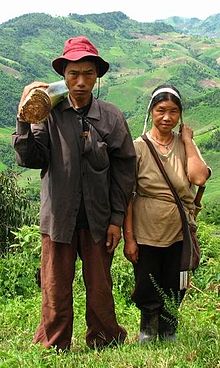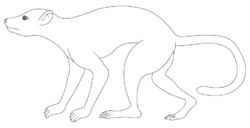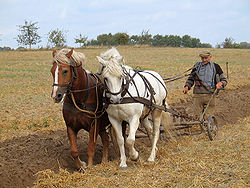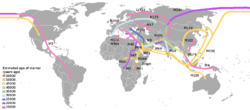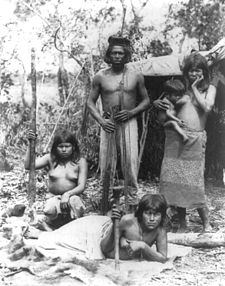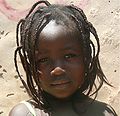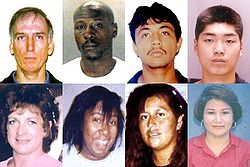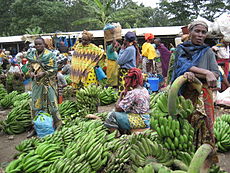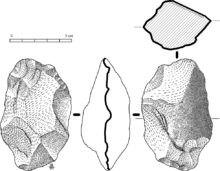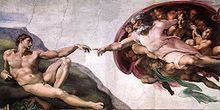- Human
-
"Homo sapiens" redirects here. For other uses, see Homo sapiens (disambiguation).This article is about modern humans. For other human species, see Homo. For other uses, see Human (disambiguation).
Human[1]
Temporal range: 0.195–0 Ma Pleistocene – RecentConservation status Scientific classification 
Kingdom: Animalia Phylum: Chordata Class: Mammalia Order: Primates Family: Hominidae Tribe: Hominini Genus: Homo Species: H. sapiens Binomial name Homo sapiens
Linnaeus, 1758Subspecies †Homo sapiens idaltu
Homo sapiens sapiens
Range of Homo sapiens (green) Synonyms - aethiopicus
Bory de St. Vincent, 1825 - americanus
Bory de St. Vincent, 1825 - arabicus
Bory de St. Vincent, 1825 - aurignacensis
Klaatsch & Hauser, 1910 - australasicus
Bory de St. Vincent, 1825 - cafer
Bory de St. Vincent, 1825 - capensis
Broom, 1917 - columbicus
Bory de St. Vincent, 1825 - cro-magnonensis
Gregory, 1921 - drennani
Kleinschmidt, 1931 - eurafricanus
(Sergi, 1911) - grimaldiensis
Gregory, 1921 - grimaldii
Lapouge, 1906 - hottentotus
Bory de St. Vincent, 1825 - hyperboreus
Bory de St. Vincent, 1825 - indicus
Bory de St. Vincent, 1825 - japeticus
Bory de St. Vincent, 1825 - melaninus
Bory de St. Vincent, 1825 - monstrosus
Linnaeus, 1758 - neptunianus
Bory de St. Vincent, 1825 - palestinus
McCown & Keith, 1932 - patagonus
Bory de St. Vincent, 1825 - priscus
Lapouge, 1899 - proto-aethiopicus
Giuffrida-Ruggeri, 1915 - scythicus
Bory de St. Vincent, 1825 - sinicus
Bory de St. Vincent, 1825 - spelaeus
Lapouge, 1899 - troglodytes
Linnaeus, 1758 - wadjakensis
Dubois, 1921
Humans (known taxonomically as Homo sapiens,[3][4] Latin for "wise man" or "knowing man")[5] are the only living species in the Homo genus. Anatomically modern humans originated in Africa about 200,000 years ago, reaching full behavioral modernity around 50,000 years ago.[6]
Humans have a highly developed brain and are capable of abstract reasoning, language, introspection, and problem solving. This mental capability, combined with an erect body carriage that frees the hands for manipulating objects, has allowed humans to make far greater use of tools than any other living species on Earth. Other higher-level thought processes of humans, such as self-awareness, rationality, and sapience,[7][8][9] are considered to be defining features of what constitutes a "person".[10][11]
Humans are uniquely adept at utilizing systems of communication for self-expression, the exchange of ideas, and organization. Humans create complex social structures composed of many cooperating and competing groups, from families to nations. Social interactions between humans have established an extremely wide variety of values, social norms, and rituals, which together form the basis of human society. With individuals widespread in every continent except Antarctica, humans are a cosmopolitan species. As of November 2011[update], the human population was estimated by the United Nations Population Division to be about 7 billion,[12] and by the United States Census Bureau to be about 6.97 billion.[13]
Humans are noted for their desire to understand and influence their environment, seeking to explain and manipulate phenomena through science, philosophy, mythology, and religion. This natural curiosity has led to the development of advanced tools and skills, which are passed down culturally; humans are the only species known to build fires, cook their food, clothe themselves, create art, and use numerous other technologies. The study of humans is the scientific discipline of anthropology.
Contents
Etymology
The English adjective human is a Middle English loanword from Old French humain, ultimately from Latin hūmānus, the adjective form of homō "man". The word's use as a noun (with a plural: humans) dates to the 16th century.[14] The native English term man is now often reserved for male adults, but the term mankind is occasionally used to refer to the species generally in Modern English. This use is considered by some to be obsolete.[15] The word is from Proto-Germanic *mannaz, from a Proto-Indo-European (PIE) root *man-, a cognate to Sanskrit manu-.
The generic name Homo is a learned 18th century derivation from Latin homō "man", ultimately "earthly being" (Old Latin hemō, a cognate to Old English guma "man", from PIE *dʰǵʰemon-, meaning 'earth' or 'ground').[16]
History
Evolution
 Craniums
Craniums
1. Gorilla 2. Australopithecus 3. Homo erectus 4. Neanderthal (La Chapelle aux Saints) 5. Steinheim Skull 6. EuhominidScientific study of human evolution is concerned, primarily, with the development of the genus Homo, but usually involves studying other hominids and hominines as well, such as Australopithecus. "Modern humans" are defined as the Homo sapiens species, of which the only extant subspecies is known as Homo sapiens sapiens. Homo sapiens idaltu (roughly translated as "elder wise human"), the other known subspecies, is now extinct.[17] Homo neanderthalensis, which became extinct 30,000 years ago, has sometimes been classified as a subspecies, "Homo sapiens neanderthalensis"; genetic studies now suggest that the functional DNA of modern humans and Neanderthals diverged 500,000 years ago.[18] Similarly, the discovered specimens of the Homo rhodesiensis species have been classified by some as a subspecies, but this classification is not widely accepted.
Anatomically modern humans first appear in the fossil record in Africa about 195,000 years ago, and studies of molecular biology give evidence that the approximate time of divergence from the common ancestor of all modern human populations was 200,000 years ago.[19][20][21][22][23] The broad study of African genetic diversity headed by Dr. Sarah Tishkoff found the San people to express the greatest genetic diversity among the 113 distinct populations sampled, making them one of 14 "ancestral population clusters". The research also located the origin of modern human migration in south-western Africa, near the coastal border of Namibia and Angola.[24]
The evolutionary history of primates can be traced back 65 million years. Primates are one of the oldest of all surviving placental mammal groups. The oldest known primate-like mammal species (those of the genus Plesiadapis) come from North America, but inhabited Eurasia and Africa on a wide scale during the tropical conditions of the Paleocene and Eocene. Molecular evidence suggests that the last common ancestor between humans and the remaining great apes diverged 4–8 million years ago.
The orangutans were the first group to split from the line leading to the humans, then gorillas followed by chimpanzees (genus Pan). The functional portion of human DNA is approximately 98.4% identical to that of chimpanzees when comparing single nucleotide polymorphisms (see human evolutionary genetics). Some studies put that as low as 94%. Therefore, the closest living relatives of humans are gorillas and chimpanzees, as they share a relatively recent common ancestor.[25]
Humans are probably most closely related to two chimpanzee species: the Common Chimpanzee and the Bonobo.[25] Full genome sequencing has resulted in the conclusion that "after 6.5 [million] years of separate evolution, the differences between chimpanzee and human are ten times greater than those between two unrelated people and ten times less than those between rats and mice".[attribution needed] Current estimates of suggested concurrence between functional human and chimpanzee DNA sequences range between 95% and 99%;[26][27][28][29] Early estimates indicated that the human lineage may have diverged from that of chimpanzees about five million years ago, and from that of gorillas about eight million years ago. However, a hominid skull discovered in Chad in 2001, classified as Sahelanthropus tchadensis, is approximately seven million years old, and may be evidence of an earlier divergence.[30]
Human evolution is characterised by a number of important changes—morphological, developmental, physiological, and behavioural—which have taken place since the split between the last common ancestor of humans and chimpanzees. The first major morphological change was the evolution of a bipedal locomotor adaptation from an arboreal or semi-arboreal one,[31] with all its attendant adaptations (a valgus knee, low intermembral index (long legs relative to the arms), reduced upper-body strength).
The human species developed a much larger brain than that of other primates – typically 1,400 cm³ in modern humans, over twice the size of that of a chimpanzee or gorilla. The pattern of human postnatal brain growth differs from that of other apes (heterochrony), and allows for extended periods of social learning and language acquisition in juvenile humans. Physical anthropologists[who?] argue that the differences between the structure of human brains and those of other apes are even more significant than their differences in size.
Other significant morphological changes included the evolution of a power and precision grip,[32] a reduced masticatory system, a reduction of the canine tooth, and the descent of the larynx and hyoid bone, making speech possible. An important physiological change in humans was the evolution of hidden oestrus, or concealed ovulation, which may have coincided with the evolution of important behavioural changes, such as pair bonding. Another significant behavioural change was the development of material culture, with human-made objects becoming increasingly common and diversified over time. The relationship between all these changes is the subject of ongoing debate.[33][34]
The forces of natural selection have continued to operate on human populations, with evidence that certain regions of the genome display directional selection in the past 15,000 years.[35]
Paleolithic
Further information: Recent African Origin, Archaic Homo sapiens, Upper Paleolithic, and Early human migrations Artistic expression appeared in the Upper Paleolithic: The Venus of Dolní Věstonice figurine, one of the earliest known depictions of the human body, dates to approximately 29,000–25,000 BP (Gravettian).
Artistic expression appeared in the Upper Paleolithic: The Venus of Dolní Věstonice figurine, one of the earliest known depictions of the human body, dates to approximately 29,000–25,000 BP (Gravettian).
Anatomically modern humans evolved from archaic Homo sapiens in Africa in the Middle Paleolithic, about 200,000 years ago. By the beginning of the Upper Paleolithic period (50,000 BP [Before Present]), full behavioral modernity, including language, music and other cultural universals had developed.
The out of Africa migration is estimated to have occurred about 70,000 years BP. Modern humans subsequently spread to all continents, replacing earlier hominids: they inhabited Eurasia and Oceania by 40,000 years BP, and the Americas at least 14,500 years BP.[36] A popular theory is that they displaced Homo neanderthalensis and other species descended from Homo erectus[37] (which had inhabited Eurasia as early as 2 million years ago) through more successful reproduction and competition for resources.[38] The exact manner or extent of the coexistence and interaction of these species is unknown and continues to be a controversial subject.[citation needed]
Evidence from archaeogenetics accumulating since the 1990s has lent strong support to the "out-of-Africa" scenario, and has marginalized the competing multiregional hypothesis, which proposed that modern humans evolved, at least in part, from independent hominid populations.[39]
Geneticists Lynn Jorde and Henry Harpending of the University of Utah propose that the variation in human DNA is minute compared to that of other species. They also propose that during the Late Pleistocene, the human population was reduced to a small number of breeding pairs – no more than 10,000, and possibly as few as 1,000 – resulting in a very small residual gene pool. Various reasons for this hypothetical bottleneck have been postulated, one being the Toba catastrophe theory.[40]
Transition to civilization
Until c. 10,000 years ago, most humans lived as hunter-gatherers. They generally lived in small nomadic groups known as band societies. The advent of agriculture prompted the Neolithic Revolution, when access to food surplus led to the formation of permanent human settlements, the domestication of animals and the use of metal tools for the first time in history. Agriculture encouraged trade and cooperation, and led to complex society. Because of the significance of this date for human society, it is the epoch of the Holocene calendar or Human Era.
About 6,000 years ago, the first proto-states developed in Mesopotamia, Egypt's Nile Valley and the Indus Valleys. Military forces were formed for protection, and government bureaucracies for administration. States cooperated and competed for resources, in some cases waging wars. Around 2,000–3,000 years ago, some states, such as Persia, India, China, Rome, and Greece, developed through conquest into the first expansive empires. Influential religions, such as Judaism, originating in West Asia, and Hinduism, a religious tradition that originated in South Asia, also rose to prominence at this time.
The late Middle Ages saw the rise of revolutionary ideas and technologies. In China, an advanced and urbanized society promoted innovations and sciences, such as printing and seed drilling. In India, major advancements were made in mathematics, philosophy, religion and metallurgy. The Islamic Golden Age saw major scientific advancements in Muslim empires. In Europe, the rediscovery of classical learning and inventions such as the printing press led to the Renaissance in the 14th and 15th centuries. Over the next 500 years, exploration and colonialism brought great parts of the world under European control, leading to later struggles for independence. The Scientific Revolution in the 17th century and the Industrial Revolution in the 18th–19th centuries promoted major innovations in transport, such as the railway and automobile; energy development, such as coal and electricity; and government, such as representative democracy and Communism.
With the advent of the Information Age at the end of the 20th century, modern humans live in a world that has become increasingly globalized and interconnected. As of 2010, almost 2 billion humans are able to communicate with each other via the Internet,[41] and 3.3 billion by mobile phone subscriptions.[42]
Although interconnection between humans has encouraged the growth of science, art, discussion, and technology, it has also led to culture clashes and the development and use of weapons of mass destruction. Human civilization has led to environmental destruction and pollution significantly contributing to the ongoing mass extinction of other forms of life called the holocene extinction event,[43] that may be further accelerated by global warming in the future.[44]
Habitat and population
See also: City, Town, Nomad, Camping, Farm, House, Watercraft, Infrastructure, Architecture, Building, and EngineeringEarly human settlements were dependent on proximity to water and, depending on the lifestyle, other natural resources used for subsistence, such as populations of animal prey for hunting and arable land for growing crops and grazing livestock. But humans have a great capacity for altering their habitats by means of technology; through irrigation, urban planning, construction, transport, manufacturing goods, deforestation and desertification. Deliberate habitat alteration is often done with the goals of increasing material wealth, increasing thermal comfort, improving the amount of food available, improving aesthetics, or improving ease of access to resources or other human settlements. With the advent of large-scale trade and transport infrastructure, proximity to these resources has become unnecessary, and in many places, these factors are no longer a driving force behind the growth and decline of a population. Nonetheless, the manner in which a habitat is altered is often a major determinant in population change.
Technology has allowed humans to colonize all of the continents and adapt to virtually all climates. Within the last century, humans have explored Antarctica, the ocean depths, and outer space, although large-scale colonization of these environments is not yet feasible. With a population of over six billion, humans are among the most numerous of the large mammals. Most humans (61%) live in Asia. The remainder live in the Americas (14%), Africa (14%), Europe (11%), and Oceania (0.5%).
Human habitation within closed ecological systems in hostile environments, such as Antarctica and outer space, is expensive, typically limited in duration, and restricted to scientific, military, or industrial expeditions. Life in space has been very sporadic, with no more than thirteen humans in space at any given time.[45] Between 1969 and 1972, two humans at a time spent brief intervals on the Moon. As of November 2011, no other celestial body has been visited by humans, although there has been a continuous human presence in space since the launch of the initial crew to inhabit the International Space Station on October 31, 2000. However, other celestial bodies have been visited by human-made objects.
Since 1800, the human population has increased from one billion to over six billion.[46] In 2004, some 2.5 billion out of 6.3 billion people (39.7%) lived in urban areas, and this percentage is expected to continue to rise throughout the 21st century. In February 2008, the U.N. estimated that half the world's population will live in urban areas by the end of the year.[47] Problems for humans living in cities include various forms of pollution and crime,[48] especially in inner city and suburban slums.
Humans have had a dramatic effect on the environment. As humans are rarely preyed upon, they have been described as superpredators.[49] Currently, through land development, combustion of fossil fuels and pollution, humans are thought to be the main contributor to global climate change.[50] Human activity is believed to be a major contributor to the ongoing Holocene extinction event, a form of mass extinction. If this continues at its current rate it is predicted that it will wipe out half of all species over the next century.[51][52]
Biology
Anatomy
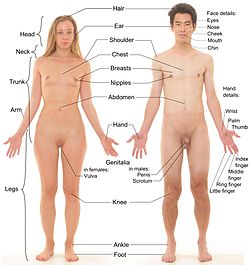 Basic anatomical features of female and male humans. These models have had body hair and male facial hair removed and head hair trimmed.
Basic anatomical features of female and male humans. These models have had body hair and male facial hair removed and head hair trimmed.
Human body types vary substantially. Although body size is largely determined by genes, it is also significantly influenced by environmental factors such as diet and exercise. The average height of an adult human is about 1.5 to 1.8 m (5 to 6 feet) tall, although this varies significantly from place to place and depending on ethnic origin.[53] The average mass of an adult human is 54–64 kg (120–140 lbs) for females and 76–83 kg (168–183 lbs) for males.[54] Weight can also vary greatly (e.g. obesity). Unlike most other primates, humans are capable of fully bipedal locomotion, thus leaving their arms available for manipulating objects using their hands, aided especially by opposable thumbs.
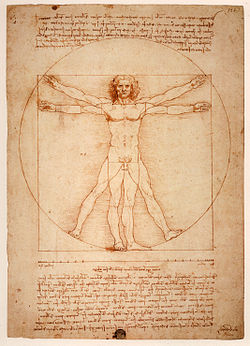 Vitruvian Man, Leonardo da Vinci's image is often used as an implied symbol of the essential symmetry of the human body, and by extension, of the universe as a whole.
Vitruvian Man, Leonardo da Vinci's image is often used as an implied symbol of the essential symmetry of the human body, and by extension, of the universe as a whole.
Although humans appear hairless compared to other primates, with notable hair growth occurring chiefly on the top of the head, underarms and pubic area, the average human has more hair follicles on his or her body than the average chimpanzee. The main distinction is that human hairs are shorter, finer, and less heavily pigmented than the average chimpanzee's, thus making them harder to see.[55]
The hue of human skin and hair is determined by the presence of pigments called melanins. Human skin hues can range from very dark brown to very pale pink. Human hair ranges from white to brown to red to most commonly black.[56] This depends on the amount of melanin (an effective sun blocking pigment) in the skin and hair, with hair melanin concentrations in hair fading with increased age, leading to grey or even white hair. Most researchers believe that skin darkening was an adaptation that evolved as a protection against ultraviolet solar radiation. However, more recently it has been argued that particular skin colors are an adaptation to balance folate, which is destroyed by ultraviolet radiation, and vitamin D, which requires sunlight to form.[57] The skin pigmentation of contemporary humans is geographically stratified, and in general correlates with the level of ultraviolet radiation. Human skin also has a capacity to darken (sun tanning) in response to exposure to ultraviolet radiation.[58][59] Humans tend to be physically weaker than other similarly sized primates, with young, conditioned male humans having been shown to be unable to match the strength of female orangutans which are at least three times stronger.[60]
The construction of the human pelvis differs from other primates, as do the toes. As a result, humans are slower for short distances than most other animals, but are among the best long-distance runners in the animal kingdom.[61] Humans' thinner body hair and more productive sweat glands also helps avoid heat exhaustion while running for long distances. For this reason persistence hunting was most likely a very successful strategy for early humans – in this method, prey is chased until it is literally exhausted. This may have also helped the early human Cro-Magnon population out-compete the Neanderthal population for food. The otherwise physically stronger Neanderthal would have much greater difficulty hunting in this way, and much more likely hunted larger game in close quarters. A trade-off for these advantages of the modern human pelvis is that childbirth is more difficult and dangerous.
The construction of modern human shoulders enable throwing weapons, which also were much more difficult or even impossible for Neanderthal competitors to use effectively.[62]
Constituents of the human body in a person weighing 60 kg[63] Constituent Weight Percentage of atoms Oxygen 38.8 kg 25.5 % Carbon 10.9 kg 9.5 % Hydrogen 6.0 kg 63.0 % Nitrogen 1.9 kg 1.4 % Other 2.4 kg 0.6 % The dental formula of Humans is the following:
 . Humans have proportionately shorter palates and much smaller teeth than other primates. They are the only primates to have short, relatively flush canine teeth. Humans have characteristically crowded teeth, with gaps from lost teeth usually closing up quickly in young specimens. Humans are gradually losing their wisdom teeth, with some individuals having them congenitally absent.[64]
. Humans have proportionately shorter palates and much smaller teeth than other primates. They are the only primates to have short, relatively flush canine teeth. Humans have characteristically crowded teeth, with gaps from lost teeth usually closing up quickly in young specimens. Humans are gradually losing their wisdom teeth, with some individuals having them congenitally absent.[64]Physiology
Human physiology is the science of the mechanical, physical, and biochemical functions of humans in good health, their organs, and the cells of which they are composed. The principal level of focus of physiology is at the level of organs and systems. Most aspects of human physiology are closely homologous to corresponding aspects of animal physiology, and animal experimentation has provided much of the foundation of physiological knowledge. Anatomy and physiology are closely related fields of study: anatomy, the study of form, and physiology, the study of function, are intrinsically tied and are studied in tandem as part of a medical curriculum.
Genetics
Humans are a eukaryotic species. Each diploid cell has two sets of 23 chromosomes, each set received from one parent. There are 22 pairs of autosomes and one pair of sex chromosomes. By present estimates, humans have approximately 20,000–25,000 genes. Like other mammals, humans have an XY sex-determination system, so that females have the sex chromosomes XX and males have XY. The X chromosome carries many genes not on the Y chromosome, which means that recessive diseases associated with X-linked genes, such as haemophilia, affect men more often than women.
Life cycle
The zygote divides inside the female's uterus to become an embryo, which over a period of thirty-eight weeks (9 months) of gestation becomes a fetus. After this span of time, the fully grown fetus is birthed from the woman's body and breathes independently as an infant for the first time. At this point, most modern cultures recognize the baby as a person entitled to the full protection of the law, though some jurisdictions extend various levels of personhood earlier to human fetuses while they remain in the uterus.
Compared with other species, human childbirth is dangerous. Painful labors lasting twenty-four hours or more are not uncommon and sometimes leads to the death of the mother, or the child.[65] This is because of both the relatively large fetal head circumference (for housing the brain) and the mother's relatively narrow pelvis (a trait required for successful bipedalism, by way of natural selection).[66][67] The chances of a successful labor increased significantly during the 20th century in wealthier countries with the advent of new medical technologies. In contrast, pregnancy and natural childbirth remain hazardous ordeals in developing regions of the world, with maternal death rates approximately 100 times more common than in developed countries.[68]
In developed countries, infants are typically 3–4 kg (6–9 pounds) in weight and 50–60 cm (20–24 inches) in height at birth.[69] However, low birth weight is common in developing countries, and contributes to the high levels of infant mortality in these regions.[70] Helpless at birth, humans continue to grow for some years, typically reaching sexual maturity at 12 to 15 years of age. Females continue to develop physically until around the age of 18, whereas male development continues until around age 21. The human life span can be split into a number of stages: infancy, childhood, adolescence, young adulthood, adulthood and old age. The lengths of these stages, however, have varied across cultures and time periods. Compared to other primates, humans experience an unusually rapid growth spurt during adolescence, where the body grows 25% in size. Chimpanzees, for example, grow only 14%, with no pronounced spurt.[71] The presence of the growth spurt is probably necessary to keep children physically small until they are psychologically mature. Humans are one of the few species in which females undergo menopause. It has been proposed that menopause increases a woman's overall reproductive success by allowing her to invest more time and resources in her existing offspring and/or their children (the grandmother hypothesis), rather than by continuing to bear children into old age.[72][73]
There are significant differences in life expectancy around the world. The developed world is generally aging, with the median age around 40 years. In the developing world the median age is between 15 and 20 years. Life expectancy at birth in Hong Kong is 84.8 years for a female and 78.9 for a male, while in Swaziland, primarily because of AIDS, it is 31.3 years for both sexes.[74] While one in five Europeans is 60 years of age or older, only one in twenty Africans is 60 years of age or older.[75] The number of centenarians (humans of age 100 years or older) in the world was estimated by the United Nations at 210,000 in 2002.[76] At least one person, Jeanne Calment, is known to have reached the age of 122 years; higher ages have been claimed but they are not well substantiated. Worldwide, there are 81 men aged 60 or older for every 100 women of that age group, and among the oldest, there are 53 men for every 100 women.
- A selection of different humans at various stages of the human life cycle
-
Girl (before puberty)
-
Woman of reproductive age
-
Older woman (after menopause)
-
Adult man
Race and ethnicity
Humans often categorize themselves in terms of race or ethnicity, sometimes on the basis of differences in appearance. Human racial categories have been based on both ancestry and visible traits, especially facial features, skull shape, skin color and hair texture. Most current genetic and archaeological evidence supports a recent single origin of modern humans in East Africa[77] with first migrations placed at 60,000 years ago. Current genetic studies have demonstrated that humans on the African continent are most genetically diverse.[78] However, compared to the other great apes, human gene sequences are remarkably homogeneous.[79][80][81][82] The predominance of genetic variation occurs within racial groups, with only 5 to 15% of total variation occurring between groups.[83] Thus the scientific concept of variation in the human genome is largely incongruent with the cultural concept of ethnicity or race. Ethnic groups are defined by linguistic, cultural, ancestral, national or regional ties. Self-identification with an ethnic group is usually based on kinship and descent. Race and ethnicity are among major factors in social identity giving rise to various forms of identity politics, e.g., racism.
There is no scientific consensus of a list of the human races, and few anthropologists endorse the notion of human "race".[84] For example, a color terminology for race includes the following in a classification of human races: Black (e.g. Sub-Saharan Africa), Red (e.g. Native Americans), Yellow (e.g. East Asians), White (e.g. Europeans) and Brown (e.g. South Asians).
Referring to natural species, in general, the term "race" is obsolete, particularly if a species is uniformly distributed on a territory. In its modern scientific connotation, the term is not applicable to a species as genetically homogeneous as the human one, as stated in the declaration on race (UNESCO 1950).[85] Genetic studies have substantiated the absence of clear biological borders, thus the term "race" is rarely used in scientific terminology, both in biological anthropology and in human genetics.[citation needed] What in the past had been defined as "races"—e.g., whites, blacks, or Asians—are now defined as "ethnic groups" or "populations", in correlation with the field (sociology, anthropology, genetics) in which they are considered.[citation needed]
Diet
Humans are omnivorous, capable of consuming a wide variety of plant and animal material.[86][87] Varying with available food sources in regions of habitation, and also varying with cultural and religious norms, human groups have adopted a range of diets, from purely vegetarian to primarily carnivorous. In some cases, dietary restrictions in humans can lead to deficiency diseases; however, stable human groups have adapted to many dietary patterns through both genetic specialization and cultural conventions to use nutritionally balanced food sources.[88] The human diet is prominently reflected in human culture, and has led to the development of food science.
Until the development of agriculture approximately 10,000 years ago, Homo sapiens employed a hunter-gatherer method as their sole means of food collection. This involved combining stationary food sources (such as fruits, grains, tubers, and mushrooms, insect larvae and aquatic molluscs) with wild game, which must be hunted and killed in order to be consumed.[89] It has been proposed that members of H. sapiens have used fire to prepare and cook food since the time of their divergence from Homo rhodesiensis (which itself had previously speciated from Homo erectus).[90] Around ten thousand years ago, humans developed agriculture,[91] which substantially altered their diet. This change in diet may also have altered human biology; with the spread of dairy farming providing a new and rich source of food, leading to the evolution of the ability to digest lactose in some adults.[92][93] Agriculture led to increased populations, the development of cities, and because of increased population density, the wider spread of infectious diseases. The types of food consumed, and the way in which they are prepared, has varied widely by time, location, and culture.
In general, humans can survive for two to eight weeks without food, depending on stored body fat. Survival without water is usually limited to three or four days. About 36 million humans die every year from causes directly or indirectly related to hunger.[94] Childhood malnutrition is also common and contributes to the global burden of disease.[95] However global food distribution is not even, and obesity among some human populations has increased rapidly, leading to health complications and increased mortality in some developed, and a few developing countries. Worldwide over one billion people are obese,[96] while in the United States 35% of people are obese, leading to this being described as an "obesity epidemic".[97] Obesity is caused by consuming more calories than are expended, so excessive weight gain is usually caused by a combination of an energy-dense high fat diet and insufficient exercise.[96]
Sleep
Humans are generally diurnal. The average sleep requirement is between seven and nine hours per day for an adult and nine to ten hours per day for a child; elderly people usually sleep for six to seven hours. Experiencing less sleep than this is common in modern societies; this sleep deprivation can have negative effects. A sustained restriction of adult sleep to four hours per day has been shown to correlate with changes in physiology and mental state, including fatigue, aggression, and bodily discomfort.[citation needed]
Psychology
The human brain, the focal point of the central nervous system in humans, controls the peripheral nervous system. In addition to controlling "lower", involuntary, or primarily autonomic activities such as respiration and digestion, it is also the locus of "higher" order functioning such as thought, reasoning, and abstraction.[98] These cognitive processes constitute the mind, and, along with their behavioral consequences, are studied in the field of psychology.
Generally regarded as more capable of these higher order activities, the human brain is believed to be more "intelligent" in general than that of any other known species. While some non-human species are capable of creating structures and using simple tools—mostly through instinct and mimicry—human technology is vastly more complex, and is constantly evolving and improving through time.
Although being vastly more advanced than many species in cognitive abilities, most of these abilities are known in primitive form among other species. Modern anthropology has tended to bear out Darwin's proposition that "the difference in mind between man and the higher animals, great as it is, certainly is one of degree and not of kind".[99]
Consciousness and thought
Humans are one of only nine species known to pass the mirror test—which tests whether an animal recognizes its reflection as an image of itself—along with all the great apes (gorillas, chimpanzees, orangutans, bonobos), Bottlenose dolphins, Asian elephants, European Magpies, and Orcas.[100] Most human children will pass the mirror test at 18 months old.[101] However, the usefulness of this test as a true test of consciousness has been disputed, and this may be a matter of degree rather than a sharp divide. Monkeys have been trained to apply abstract rules in tasks.[102]
The human brain perceives the external world through the senses, and each individual human is influenced greatly by his or her experiences, leading to subjective views of existence and the passage of time. Humans are variously said to possess consciousness, self-awareness, and a mind, which correspond roughly to the mental processes of thought. These are said to possess qualities such as self-awareness, sentience, sapience, and the ability to perceive the relationship between oneself and one's environment. The extent to which the mind constructs or experiences the outer world is a matter of debate, as are the definitions and validity of many of the terms used above. The philosopher of cognitive science Daniel Dennett, for example, argues that there is no such thing as a narrative centre called the "mind", but that instead there is simply a collection of sensory inputs and outputs: different kinds of "software" running in parallel.[103] Psychologist B.F. Skinner argued that the mind is an explanatory fiction that diverts attention from environmental causes of behavior,[104] and that what are commonly seen as mental processes may be better conceived of as forms of covert verbal behavior.[105][106]
Humans study the more physical aspects of the mind and brain, and by extension of the nervous system, in the field of neurology, the more behavioral in the field of psychology, and a sometimes loosely defined area between in the field of psychiatry, which treats mental illness and behavioral disorders. Psychology does not necessarily refer to the brain or nervous system, and can be framed purely in terms of phenomenological or information processing theories of the mind. Increasingly, however, an understanding of brain functions is being included in psychological theory and practice, particularly in areas such as artificial intelligence, neuropsychology, and cognitive neuroscience.
The nature of thought is central to psychology and related fields. Cognitive psychology studies cognition, the mental processes' underlying behavior. It uses information processing as a framework for understanding the mind. Perception, learning, problem solving, memory, attention, language and emotion are all well researched areas as well. Cognitive psychology is associated with a school of thought known as cognitivism, whose adherents argue for an information processing model of mental function, informed by positivism and experimental psychology. Techniques and models from cognitive psychology are widely applied and form the mainstay of psychological theories in many areas of both research and applied psychology. Largely focusing on the development of the human mind through the life span, developmental psychology seeks to understand how people come to perceive, understand, and act within the world and how these processes change as they age. This may focus on intellectual, cognitive, neural, social, or moral development.
Some philosophers divide consciousness into phenomenal consciousness, which is experience itself, and access consciousness, which is the processing of the things in experience.[107] Phenomenal consciousness is the state of being conscious, such as when they say "I am conscious." Access consciousness is being conscious of something in relation to abstract concepts, such as when one says "I am conscious of these words." Various forms of access consciousness include awareness, self-awareness, conscience, stream of consciousness, Husserl's phenomenology, and intentionality. The concept of phenomenal consciousness, in modern history, according to some, is closely related to the concept of qualia. Social psychology links sociology with psychology in their shared study of the nature and causes of human social interaction, with an emphasis on how people think towards each other and how they relate to each other. The behavior and mental processes, both human and non-human, can be described through animal cognition, ethology, evolutionary psychology, and comparative psychology as well. Human ecology is an academic discipline that investigates how humans and human societies interact with both their natural environment and the human social environment.
Motivation and emotion
Motivation is the driving force of desire behind all deliberate actions of humans. Motivation is based on emotion—specifically, on the search for satisfaction (positive emotional experiences), and the avoidance of conflict. Positive and negative is defined by the individual brain state, which may be influenced by social norms: a person may be driven to self-injury or violence because his brain is conditioned to create a positive response to these actions. Motivation is important because it is involved in the performance of all learned responses. Within psychology, conflict avoidance and the libido are seen to be primary motivators. Within economics, motivation is often seen to be based on incentives; these may be financial, moral, or coercive. Religions generally posit divine or demonic influences.
Happiness, or the state of being happy, is a human emotional condition. The definition of happiness is a common philosophical topic. Some people might define it as the best condition that a human can have—a condition of mental and physical health. Others define it as freedom from want and distress; consciousness of the good order of things; assurance of one's place in the universe or society.
Emotion has a significant influence on, or can even be said to control, human behavior, though historically many cultures and philosophers have for various reasons discouraged allowing this influence to go unchecked. Emotional experiences perceived as pleasant, such as love, admiration, or joy, contrast with those perceived as unpleasant, like hate, envy, or sorrow. There is often a distinction made between refined emotions that are socially learned and survival oriented emotions, which are thought to be innate. Human exploration of emotions as separate from other neurological phenomena is worthy of note, particularly in cultures where emotion is considered separate from physiological state. In some cultural medical theories emotion is considered so synonymous with certain forms of physical health that no difference is thought to exist. The Stoics believed excessive emotion was harmful, while some Sufi teachers felt certain extreme emotions could yield a conceptual perfection, what is often translated as ecstasy.
In modern scientific thought, certain refined emotions are considered a complex neural trait innate in a variety of domesticated and non-domesticated mammals. These were commonly developed in reaction to superior survival mechanisms and intelligent interaction with each other and the environment; as such, refined emotion is not in all cases as discrete and separate from natural neural function as was once assumed. However, when humans function in civilized tandem, it has been noted that uninhibited acting on extreme emotion can lead to social disorder and crime.
Society and culture
Human society statistics World population 7 billion Population density 12.7 per km² (4.9 mi²) by total area
43.6 per km² (16.8 mi²) by land areaLargest agglomerations Beijing, Bogotá, Buenos Aires, Cairo, Delhi, Dhaka, Guangzhou, Istanbul, Jakarta, Karachi, Kinshasa, Kolkata, Lagos, Lima, London, Los Angeles, Manila, Mexico City, Moscow, Mumbai, New York City, Osaka, Paris, Rio de Janeiro, São Paulo, Seoul, Shanghai, Shenzen, Tehran, Tianjin, Tokyo, Wuhan Most widely spoken languages[108] Mandarin Chinese, English, Spanish, Arabic, Hindi, Bengali, Portuguese, Russian, Japanese, German, Javanese, Punjabi, Telugu, Vietnamese, French, Marathi, Turkish, Korean, Tamil, Italian, Urdu, Indonesian Most popular religions[109] Christianity, Islam, Hinduism, Buddhism, Sikhism, Judaism, Baha'i GDP (nominal) $36,356,240 million USD
($5,797 USD per capita)GDP (PPP) $51,656,251 million IND
($8,236 per capita)Humans are social beings. In comparisons with animalia, humans are regarded like the primates for their social qualities. But beyond any other creature, humans are adept at utilizing systems of communication for self-expression, the exchange of ideas, and organization, and as such have created complex social structures composed of many cooperating and competing groups. Human groups range from families to nations. Social interactions between humans have established an extremely wide variety of values, social norms, and rituals, which together form the basis of human society.
Culture is defined here as patterns of complex symbolic behavior, i.e. all behavior that is not innate but which has to be learned through social interaction with others; such as the use of distinctive material and symbolic systems, including language, ritual, social organization, traditions, beliefs and technology.
Sexuality and love
Human sexuality, besides ensuring biological reproduction, has important social functions: it creates physical intimacy, bonds, and hierarchies among individuals; and in a hedonistic sense to the enjoyment of activity involving sexual gratification. Sexual desire, or libido, is experienced as a bodily urge, often accompanied by strong emotions such as love, ecstasy and jealousy. The extreme importance of sexuality in the human species can be seen in a number of physical features, among them hidden ovulation, the evolution of external scrotum and penis suggesting sperm competition, the absence of an os penis, permanent secondary sexual characteristics, the forming of pair bonds based on sexual attraction as a common social structure and sexual ability in females outside of ovulation. These adaptations indicate that the importance of sexuality in humans is on a par with that found in the Bonobo, and that the complex human sexual behaviour has a long evolutionary history.
Human choices in acting on sexuality are commonly influenced by cultural norms, which vary widely. Restrictions are often determined by religious beliefs or social customs. The pioneering researcher Sigmund Freud believed that humans are born polymorphously perverse, which means that any number of objects could be a source of pleasure. According to Freud, humans then pass through five stages of psychosexual development (and can fixate on any stage because of various traumas during the process). For Alfred Kinsey, another influential sex researcher, people can fall anywhere along a continuous scale of sexual orientation (with only small minorities fully heterosexual or homosexual). Recent studies of neurology and genetics suggest people may be born predisposed to various sexual tendencies.[110][111]
Gender roles
The sexual division of humans into male and female has been marked culturally by a corresponding division of roles, norms, practices, dress, behavior, rights, duties, privileges, status, and power. Cultural differences by gender have often been believed to have arisen naturally out of a division of reproductive labor; the biological fact that women give birth led to their further cultural responsibility for nurturing and caring for children and households. Gender roles have varied historically, and challenges to predominant gender norms have recurred in many societies.
Society, government, and politics
 The United Nations complex in New York City, which houses one of the largest political organizations in the world.
The United Nations complex in New York City, which houses one of the largest political organizations in the world.
Society is the system of organizations and institutions arising from interaction between humans. A state is an organized political community occupying a definite territory, having an organized government, and possessing internal and external sovereignty. Recognition of the state's claim to independence by other states, enabling it to enter into international agreements, is often important to the establishment of its statehood. The "state" can also be defined in terms of domestic conditions, specifically, as conceptualized by Max Weber, "a state is a human community that (successfully) claims the monopoly of the 'legitimate' use of physical force within a given territory."[112]
Government can be defined as the political means of creating and enforcing laws; typically via a bureaucratic hierarchy. Politics is the process by which decisions are made within groups; this process often involves conflict as well as compromise. Although the term is generally applied to behavior within governments, politics is also observed in all human group interactions, including corporate, academic, and religious institutions. Many different political systems exist, as do many different ways of understanding them, and many definitions overlap. Examples of governments include monarchy, Communist state, military dictatorship, theocracy, and liberal democracy, the last of which is considered dominant today. All of these issues have a direct relationship with economics.
Trade and economics
Trade is the voluntary exchange of goods and services, and is a form of economics. A mechanism that allows trade is called a market. The original form of trade was barter, the direct exchange of goods and services. Modern traders instead generally negotiate through a medium of exchange, such as money. As a result, buying can be separated from selling, or earning. The invention of money (and later credit, paper money and non-physical money) greatly simplified and promoted trade. Because of specialization and division of labor, most people concentrate on a small aspect of manufacturing or service, trading their labour for products. Trade exists between regions because different regions have an absolute or comparative advantage in the production of some tradable commodity, or because different regions' size allows for the benefits of mass production.
Economics is a social science which studies the production, distribution, trade, and consumption of goods and services. Economics focuses on measurable variables, and is broadly divided into two main branches: microeconomics, which deals with individual agents, such as households and businesses, and macroeconomics, which considers the economy as a whole, in which case it considers aggregate supply and demand for money, capital and commodities. Aspects receiving particular attention in economics are resource allocation, production, distribution, trade, and competition. Economic logic is increasingly applied to any problem that involves choice under scarcity or determining economic value.
War
War is a state of widespread conflict between states or other large groups of humans, which is characterized by the use of lethal violence between combatants and/or upon civilians. (Humans also engage in lesser conflicts, such as brawls, riots, revolts, and melees. A revolution may or may not involve warfare.) It is estimated that during the 20th century between 167 and 188 million humans died as a result of war.[113] A common perception of war is a series of military campaigns between at least two opposing sides involving a dispute over sovereignty, territory, resources, religion, or other issues. A war between internal elements of a state is a civil war.
There have been a wide variety of rapidly advancing tactics throughout the history of war, ranging from conventional war to asymmetric warfare to total war and unconventional warfare. Techniques include hand to hand combat, the use of ranged weapons, Naval warfare, and, more recently, air support. Military intelligence has often played a key role in determining victory and defeat. Propaganda, which often includes information, slanted opinion and disinformation, plays a key role in maintaining unity within a warring group, and/or sowing discord among opponents. In modern warfare, soldiers and combat vehicles are used to control the land, warships the sea, and aircraft the sky. These fields have also overlapped in the forms of marines, paratroopers, naval aircraft carriers, and surface-to-air missiles, among others. Satellites in low Earth orbit have made outer space a factor in warfare as well as it is used for detailed intelligence gathering, however no known aggressive actions have been taken from space.
Material culture and technology
Stone tools were used by proto-humans at least 2.5 million years ago.[114] The controlled use of fire began around 1.5 million years ago. Since then, humans have made major advances, developing complex technology to create tools to aid their lives and allowing for other advancements in culture. Major leaps in technology include the discovery of agriculture – what is known as the Neolithic Revolution; and the invention of automated machines in the Industrial Revolution.
Archaeology attempts to tell the story of past or lost cultures in part by close examination of the artifacts they produced. Early humans left stone tools, pottery, and jewelry that are particular to various regions and times.
Language
The capacity humans have to transfer concepts, ideas and notions through speech and writing is unrivaled in known species. Unlike the call systems of other primates that are closed, human language is far more open, and gains variety in different situations. The human language has the quality of displacement, using words to represent things and happenings that are not presently or locally occurring, but elsewhere or at a different time.[64] In this way data networks are important to the continuing development of language. The faculty of speech is a defining feature of humanity, possibly predating phylogenetic separation of the modern population. Language is central to the communication between humans, as well as being central to the sense of identity that unites nations, cultures and ethnic groups. The invention of writing systems at least 5,000 years ago allowed the preservation of language on material objects, and was a major step in cultural evolution. The science of linguistics describes the structure of language and the relationship between languages. There are approximately 6,000 different languages currently in use, including sign languages, and many thousands more that are considered extinct.
Spirituality and religion
Religion is generally defined as a belief system concerning the supernatural, sacred or divine, and practices, values, institutions and rituals associated with such belief. Some religions also have a moral code. The evolution and the history of the first religions have recently become areas of active scientific investigation.[115][116][117] However, in the course of its development, religion has taken on many forms that vary by culture and individual perspective. Some of the chief questions and issues religions are concerned with include life after death (commonly involving belief in an afterlife), the origin of life, the nature of the universe (religious cosmology) and its ultimate fate (eschatology), and what is moral or immoral. A common source for answers to these questions are beliefs in transcendent divine beings such as deities or a singular God, although not all religions are theistic. Spirituality, belief or involvement in matters of the soul or spirit, is one of the many different approaches humans take in trying to answer fundamental questions about humankind's place in the universe, the meaning of life, and the ideal way to live one's life. Though these topics have also been addressed by philosophy, and to some extent by science, spirituality is unique in that it focuses on mystical or supernatural concepts such as karma and God.
Although the exact level of religiosity can be hard to measure,[118] a majority of humans professes some variety of religious or spiritual belief, although some are irreligious. Other humans have no religious beliefs and are atheists, scientific skeptics, agnostics or simply non-religious. Humanism is a philosophy which seeks to include all of humanity and all issues common to humans; it is usually non-religious. Additionally, although most religions and spiritual beliefs are clearly distinct from science on both a philosophical and methodological level, the two are not generally considered mutually exclusive; a majority of humans holds a mix of both scientific and religious views. The distinction between philosophy and religion, on the other hand, is at times less clear, and the two are linked in such fields as the philosophy of religion and theology.
Philosophy and self-reflection
Philosophy is a discipline or field of study involving the investigation, analysis, and development of ideas at a general, abstract, or fundamental level. It is the discipline searching for a general understanding of reality, reasoning and values. Major fields of philosophy include logic, metaphysics, epistemology, philosophy of mind, and axiology (which includes ethics and aesthetics). Philosophy covers a very wide range of approaches, and is used to refer to a worldview, to a perspective on an issue, or to the positions argued for by a particular philosopher or school of philosophy.
Science and mathematics
Scientific approach and mathematics have been unique to humans.
Mathematics is connected to language, and it is argued that this special genetic trait of humans, linked to language and abstract thought is responsible for the mathematical ability.
Closely related is humans' ability to model the world and use science. Although scientific revolution is relatively recent, humans have attempted to explain their environment since the ancient times.
Art, music, and literature
Artistic works have existed for almost as long as humankind, from early pre-historic art to contemporary art. Art is one of the most unusual aspects of human behaviour and a key distinguishing feature of humans from other species.
As a form of cultural expression by humans, art may be defined by the pursuit of diversity and the usage of narratives of liberation and exploration (i.e. art history, art criticism, and art theory) to mediate its boundaries. This distinction may be applied to objects or performances, current or historical, and its prestige extends to those who made, found, exhibit, or own them. In the modern use of the word, art is commonly understood to be the process or result of making material works that, from concept to creation, adhere to the "creative impulse" of human beings. Art is distinguished from other works by being in large part unprompted by necessity, by biological drive, or by any undisciplined pursuit of recreation.
Music is a natural intuitive phenomenon based on the three distinct and interrelated organization structures of rhythm, harmony, and melody. Listening to music is perhaps the most common and universal form of entertainment for humans, while learning and understanding it are popular disciplines. There are a wide variety of music genres and ethnic musics. Literature, the body of written—and possibly oral—works, especially creative ones, includes prose, poetry and drama, both fiction and non-fiction. Literature includes such genres as epic, legend, myth, ballad, and folklore.
See also
- Human impact on the environment
References
- ^ a b Groves, C. (2005). Wilson, D. E., & Reeder, D. M, eds. ed. Mammal Species of the World (3rd ed.). Baltimore: Johns Hopkins University Press. OCLC 62265494. ISBN 0-801-88221-4. http://www.bucknell.edu/msw3/browse.asp?id=12100795.
- ^ Global Mammal Assessment Team (2008). Homo sapiens. In: IUCN 2009. IUCN Red List of Threatened Species. Version 2009.2. <www.iucnredlist.org>. Downloaded on 03 March 2010.
- ^ Goodman M, Tagle D, Fitch D, Bailey W, Czelusniak J, Koop B, Benson P, Slightom J (1990). "Primate evolution at the DNA level and a classification of hominoids". J Mol Evol 30 (3): 260–266. doi:10.1007/BF02099995. PMID 2109087.
- ^ "Hominidae Classification". Animal Diversity Web @ UMich. http://animaldiversity.ummz.umich.edu/site/accounts/classification/Hominidae.html. Retrieved 2006-09-25.
- ^ hŏmo, săpĭens, săpĭo. Charlton T. Lewis and Charles Short. A Latin Dictionary on Perseus Project.
- ^ "Human Evolution by The Smithsonian Institution's Human Origins Program". Human Origins Initiative. Smithsonian Institution. http://www.mnh.si.edu/anthro/humanorigins/ha/sap.htm. Retrieved 2010-08-30.
- ^ Dependent Rational Animals: Why Human Beings Need the Virtues By Alasdair MacIntyre pp. 60, "But this [language] is insufficient for human rationality, What is needed in addition is the ability to construct sentences that contain as constituents either the sentences use to express the judgment about which the agent is reflecting, or references to those sentences."
- ^ John McDowell, Mind and World, 1994. p.115, Harvard University Press, (quoted in Dependent Rational Animals, by Alasdair MacIntyre): "In mere animals, sentience is in the service of a mode of life that is structured exclusively by immediate biological imperatives" [..] "merely animal life is shaped by goals whose control of the animal's behavior at a given moment is an immediate outcome of biological forces"
- ^ The Really Hard Problem:Meaning in a Material World, Owen Flanagan, MIT Press
- ^ Dependent Rational Animals: Why Human Beings Need the Virtues By Alasdair MacIntyre pp. 60, "Those who have wanted to draw a single sharp line between human and nonhuman animals have commonly laid emphasis upon the presence or absence of language as such, the ability to use and to respond to strings of syntactically ordered and semantically significant expressions whose utterance constitutes speech acts. But this is insufficient for human rationality. What is needed in addition.."
- ^ Nature vs. Nurture: The Miracle of Language, by Malia Knezek. "What about the fact that other animals do not have similar language capabilities? [..] This obviously involves some innate difference between humans and other animals.. [..] ..other animals do not use any other form of language (i.e. sign language) even though they have the physiological capabilities." citing, Andy Clark. Being There: Putting Brain, Body, and World Together Again. The MIT Press, 1997. 208-209).
- ^ Roberts, Sam (31 October 2011). "U.N. Reports 7 Billion Humans, but Others Don’t Count on It". The New York Times. http://www.nytimes.com/2011/11/01/world/united-nations-reports-7-billion-humans-but-others-dont-count-on-it.html?_r=1. Retrieved 2011-11-07.
- ^ "World Population Clock". Census.gov. United States Census Bureau, Population Division. http://www.census.gov/population/popclockworld.html. Retrieved 2011-11-02.
- ^ OED, s.v. "human".
- ^ The OED considers obsolete the sense "a designation applied equally to particular individuals of either sex", citing a 1597 source as the most recent (The Lord had but one paire of men in Paradise.) while it continues to endorse the sense "as a general or indefinite designation" as current in English.
- ^ Porkorny (1959) s.v. "g'hðem" pp. 414–416; "Homo." Dictionary.com Unabridged (v 1.1). Random House, Inc. 23 Sep. 2008. "Homo". Dictionary.com. http://dictionary.reference.com/browse/Homo.
- ^ Human evolution: the fossil evidence in 3D, by Philip L. Walker and Edward H. Hagen, Dept. of Anthropology, University of California, Santa Barbara. Retrieved April 5, 2005.
- ^ Green, R. E., Krause, J, Ptak, S. E., Briggs, A. W., Ronan, M. T., Simons, J. F., et al. (2006). Analysis of one million base pairs of Neanderthal DNA. Nature. pp. 16, 330–336. http://www.nature.com/nature/journal/v444/n7117/abs/nature05336.html.
- ^ nsf.gov - National Science Foundation (NSF) News - New Clues Add 40,000 Years to Age of Human Species - US National Science Foundation (NSF)
- ^ "Age of ancient humans reassessed". BBC News. February 16, 2005. http://news.bbc.co.uk/2/hi/science/nature/4269299.stm. Retrieved April 10, 2010.
- ^ The Oldest Homo Sapiens: – URL retrieved May 15, 2009
- ^ Alemseged, Z., Coppens, Y., Geraads, D. (2002). "Hominid cranium from Homo: Description and taxonomy of Homo-323-1976-896". Am J Phys Anthropol 117 (2): 103–12. doi:10.1002/ajpa.10032. PMID 11815945.
- ^ Stoneking, Mark; Soodyall, Himla (1996). "Human evolution and the mitochondrial genome". Current Opinion in Genetics & Development 6 (6): 731–6. doi:10.1016/S0959-437X(96)80028-1.
- ^ Gill, Victoria (May 1, 2009). "Africa's genetic secrets unlocked". BBC News. http://news.bbc.co.uk/2/hi/science/nature/8027269.stm.; the results were published in the online edition of the journal Science.
- ^ a b Wood B, Richmond BG (July 2000). "Human evolution: taxonomy and paleobiology". J. Anat. 197 ( Pt 1): 19–60. doi:10.1046/j.1469-7580.2000.19710019.x. PMC 1468107. PMID 10999270. http://www.pubmedcentral.nih.gov/articlerender.fcgi?tool=pmcentrez&artid=1468107.
- ^ Frans de Waal, Bonobo. Berkeley: University of California Press, 1997. ISBN 0-520-20535-9 [1]
- ^ Britten RJ (2002). "Divergence between samples of chimpanzee and human DNA sequences is 5%, counting indels". Proc Natl Acad Sci USA 99 (21): 13633–5. doi:10.1073/pnas.172510699. PMC 129726. PMID 12368483. http://www.pnas.org/cgi/content/full/99/21/13633.
- ^ Wildman, D., Uddin, M., Liu, G., Grossman, L., Goodman, M. (2003). "Implications of natural selection in shaping 99.4% nonsynonymous DNA identity between humans and chimpanzees: enlarging genus Homo". Proc Natl Acad Sci USA 100 (12): 7181–8. doi:10.1073/pnas.1232172100. PMC 165850. PMID 12766228. http://www.pnas.org/cgi/content/full/100/12/7181.
- ^ Ruvolo M (1 March 1997). "Molecular phylogeny of the hominoids: inferences from multiple independent DNA sequence data sets". Mol Biol Evol 14 (3): 248–65. PMID 9066793. http://mbe.oxfordjournals.org/cgi/reprint/14/3/248.
- ^ Brunet, M., Guy, F., Pilbeam, D., Mackaye, H., Likius, A., Ahounta, D., Beauvilain, A., Blondel, C., Bocherens, H., Boisserie, J., De Bonis, L., Coppens, Y., Dejax, J., Denys, C., Duringer, P., Eisenmann, V., Fanone, G., Fronty, P., Geraads, D., Lehmann, T., Lihoreau, F., Louchart, A., Mahamat, A., Merceron, G., Mouchelin, G., Otero, O., Pelaez Campomanes, P., Ponce De Leon, M., Rage, J., Sapanet, M., Schuster, M., Sudre, J., Tassy, P., Valentin, X., Vignaud, P., Viriot, L., Zazzo, A., Zollikofer, C. (2002). "A new hominid from the Upper Miocene of Chad, Central Africa". Nature 418 (6894): 145–51. doi:10.1038/nature00879. PMID 12110880. http://www.nature.com/nature/journal/v418/n6894/full/nature00879.html.
- ^ Vančata1 V., & Vančatová, M. A. "Major features in the evolution of early hominoid locomotion". Springer Netherlands, Volume 2, Number 6, December 1987. pp.517–537.
- ^ Brues, Alice M. & Snow, Clyde C. "Physical Anthropology". Biennial Review of Anthropology, Vol. 4, 1965. pp. 1–39.
- ^ Boyd, Robert & Silk, Joan B. (2003). How Humans Evolved. New York: Norton & Company. ISBN 0-393-97854-0.
- ^ Dobzhansky, Theodosius (1963). Anthropology and the natural sciences-The problem of human evolution, Current Anthropology '4 (2): 138–148.
- ^ Wade, N (2006-03-07). "Still Evolving, Human Genes Tell New Story". The New York Times. http://www.nytimes.com/2006/03/07/science/07evolve.html. Retrieved 2008-07-10.
- ^ Wolman, David (2008). "Fossil Feces Is Earliest Evidence of N. America Humans" National Geographic
- ^ Dr. D.R.Johnson. "Human Evolution : Lower and Middle Pleistocene - Homo erectus and Homo sapiens : Lecture 1 of 6". Faculty of Biological Sciences, University of Leeds.
- ^ McKie, Robin (May 17, 2009). "How Neanderthals met a grisly fate: devoured by humans". The Observer (London). http://www.guardian.co.uk/science/2009/may/17/neanderthals-cannibalism-anthropological-sciences-journal.
- ^ Eswaran V, Harpending H, Rogers AR (July 2005). "Genomics refutes an exclusively African origin of humans". J. Hum. Evol. 49 (1): 1–18. doi:10.1016/j.jhevol.2005.02.006. PMID 15878780.
- ^ Supervolcanoes, BBC2, 3 February 2000
- ^ "Internet Usage Statistics - The Internet Big Picture". internetworldstats.com/. http://www.internetworldstats.com/stats.htm. Retrieved 19 November 2010.
- ^ "Reuters homepage". Reuters. http://investing.reuters.co.uk/news/articleinvesting.aspx?type=media&storyID=nL29172095. Retrieved 19 November 2010.
- ^ Pimm S, Raven P, Peterson A, Sekercioglu CH, Ehrlich PR (2006). "Human impacts on the rates of recent, present, and future bird extinctions". Proc. Natl. Acad. Sci. U.S.A. 103 (29): 10941–6. doi:10.1073/pnas.0604181103. PMC 1544153. PMID 16829570. http://www.pubmedcentral.nih.gov/articlerender.fcgi?tool=pmcentrez&artid=1544153.
*Barnosky AD, Koch PL, Feranec RS, Wing SL, Shabel AB (2004). "Assessing the causes of late Pleistocene extinctions on the continents". Science 306 (5693): 70–5. doi:10.1126/science.1101476. PMID 15459379. - ^ Lewis OT (2006). "Climate change, species-area curves and the extinction crisis" (PDF). Philos. Trans. R. Soc. Lond., B, Biol. Sci. 361 (1465): 163–71. doi:10.1098/rstb.2005.1712. PMC 1831839. PMID 16553315. http://www.journals.royalsoc.ac.uk/content/711761513317h856/fulltext.pdf.
- ^ [2]
- ^ "World's population reaches six billion". BBC News. August 5, 1999. http://news.bbc.co.uk/1/hi/sci/tech/411162.stm. Retrieved February 5, 2008.
- ^ Whitehouse, David (May 19, 2005). "Half of humanity set to go urban". BBC News. http://news.bbc.co.uk/1/hi/sci/tech/4561183.stm.
- ^ Urban, Suburban, and Rural Victimization, 1993–98 U.S. Department of Justice, Bureau of Justice Statistics,. Accessed 29 Oct 2006
- ^ Scientific American (1998). Evolution and General Intelligence: Three hypotheses on the evolution of general intelligence.
- ^ "Climate Change 2001: Working Group I: The Scientific Basis". grida.no/. http://www.grida.no/climate/ipcc_tar/wg1/007.htm. Retrieved 2007-05-30.
- ^ American Association for the Advancement of Science. Foreword. AAAS Atlas of Population & Environment.
- ^ Wilson, E.O. (2002). in The Future of Life.
- ^ de Beer H (2004). "Observations on the history of Dutch physical stature from the late-Middle Ages to the present". Econ Hum Biol 2 (1): 45–55. doi:10.1016/j.ehb.2003.11.001. PMID 15463992.
- ^ Human weight – ArticleWorld
- ^ Why Humans and Their Fur Parted Way by Nicholas Wade, New York Times, August 19, 2003.
- ^ Rogers, Alan R., Iltis, David & Wooding, Stephen (2004). "Genetic variation at the MC1R locus and the time since loss of human body hair". Current Anthropology 45 (1): 105–108. doi:10.1086/381006.
- ^ Jablonski, N.G. & Chaplin, G. (2000). The evolution of human skin coloration (pdf), 'Journal of Human Evolution 39: 57–106.
- ^ Harding RM, Healy E, Ray AJ, et al. (April 2000). "Evidence for variable selective pressures at MC1R". Am. J. Hum. Genet. 66 (4): 1351–61. doi:10.1086/302863. PMC 1288200. PMID 10733465. http://www.pubmedcentral.nih.gov/articlerender.fcgi?tool=pmcentrez&artid=1288200.
- ^ Robin, Ashley (1991). Biological Perspectives on Human Pigmentation. Cambridge: Cambridge University Press.
- ^ Schwartz, Jeffrey (1987). The Red Ape: Orangutans and Human Origins. Cambridge, MA: Westview Press. p. 286. ISBN 0813340640.
- ^ Parker-Pope, Tara (October 27, 2009). "The Human Body Is Built for Distance". The New York Times. http://www.nytimes.com/2009/10/27/health/27well.html.
- ^ Were Neanderthals stoned to death by modern humans? - life - 20 November 2008 - New Scientist
- ^ Page 3 in Chemical storylines. Author: George Burton. Edition 2, illustrated. Publisher: Heinemann, 2000. ISBN 0-435-63119-5, 9780435631192. Length: 312 pages
- ^ a b Collins, Desmond (1976). The Human Revolution: From Ape to Artist. p. 208.
- ^ According to the July 2, 2007 Newsweek magazine, a woman dies in childbirth every minute, most often due to uncontrolled bleeding and infection, with the world's poorest women most vulnerable. The lifetime risk is 1 in 16 in sub-Saharan Africa, compared to 1 in 2,800 in developed countries.
- ^ LaVelle M (1995). "Natural selection and developmental sexual variation in the human pelvis". Am J Phys Anthropol 98 (1): 59–72. doi:10.1002/ajpa.1330980106. PMID 8579191.
- ^ Correia H, Balseiro S, De Areia M (2005). "Sexual dimorphism in the human pelvis: testing a new hypothesis". Homo 56 (2): 153–60. doi:10.1016/j.jchb.2005.05.003. PMID 16130838.
- ^ Rush D (2000). "Nutrition and maternal mortality in the developing world". Am J Clin Nutr 72 (1 Suppl): 212 S–240 S. PMID 10871588.
- ^ "Low Birthweight". Archived from the original on May 13, 2007. http://web.archive.org/web/20070513150431/http://www.childinfo.org/areas/birthweight/. Retrieved 2007-05-30.
- ^ Khor G (2003). "Update on the prevalence of malnutrition among children in Asia". Nepal Med Coll J 5 (2): 113–22. PMID 15024783.
- ^ Leakey, Richard; Lewin, Roger. Origins Reconsidered – In Search of What Makes Us Human. Sherma B.V., 1992.
- ^ Diamond, Jared (1997). Why is Sex Fun? The Evolution of Human Sexuality. Basic Books. pp. 167–170. ISBN 0-465-03127-7.
- ^ Peccei, J.S. (2001). "Menopause: Adaptation or Epiphenomenon?". Evolutionary Anthropology 10: 47–57. http://www.biology.ed.ac.uk/public/conferences/evolbiol2006/papers/Peccei.pdf.
- ^ "Human Development Report 2006," United Nations Development Programme, pp. 363–366, November 9, 2006
- ^ The World Factbook, U.S. Central Intelligence Agency. Retrieved April 2, 2005.
- ^ U.N. Statistics on Population Ageing, United Nations press release, February 28, 2002. Retrieved April 2, 2005.
- ^ Hua Liu, et al. (2006). "A Geographically Explicit Genetic Model of Worldwide Human-Settlement History" (– Scholar search). The American Journal of Human Genetics 79 (2): 230–237. doi:10.1086/505436. PMC 1559480. PMID 16826514. http://www.journals.uchicago.edu/AJHG/journal/issues/v79n2/43550/43550.html.[dead link]
- ^ Jorde L, Watkins W, Bamshad M, Dixon M, Ricker C, Seielstad M, Batzer M (2000). "The distribution of human genetic diversity: a comparison of mitochondrial, autosomal, and Y-chromosome data". Am J Hum Genet 66 (3): 979–88. doi:10.1086/302825. PMC 1288178. PMID 10712212. http://www.pubmedcentral.nih.gov/articlerender.fcgi?tool=pmcentrez&artid=1288178.
- ^ Race, Ethnicity, and Genetics Working Group (October 2005). "The use of racial, ethnic, and ancestral categories in human genetics research". Am. J. Hum. Genet. 77 (4): 519–32. doi:10.1086/491747. PMC 1275602. PMID 16175499. http://www.pubmedcentral.nih.gov/articlerender.fcgi?tool=pmcentrez&artid=1275602.
- ^ Bamshad M, Wooding S, Salisbury BA, Stephens JC (August 2004). "Deconstructing the relationship between genetics and race". Nat. Rev. Genet. 5 (8): 598–609. doi:10.1038/nrg1401. PMID 15266342.
- ^ Tishkoff SA, Kidd KK (November 2004). "Implications of biogeography of human populations for 'race' and medicine". Nat. Genet. 36 (11 Suppl): S21–7. doi:10.1038/ng1438. PMID 15507999.
- ^ Jorde LB, Wooding SP (November 2004). "Genetic variation, classification and 'race'". Nat. Genet. 36 (11 Suppl): S28–33. doi:10.1038/ng1435. PMID 15508000.
- ^ Race, Ethnicity, and Genetics Working Group (2005). "The use of racial, ethnic, and ancestral categories in human genetics research". Am J Hum Genet 77 (4): 519–32. doi:10.1086/491747. PMC 1275602. PMID 16175499. http://www.pubmedcentral.nih.gov/articlerender.fcgi?tool=pmcentrez&artid=1275602.
- ^ "Human Races: A Genetic and Evolutionary Perspective", Alan R. Templeton, American Anthropologist, New Series, Vol. 100, No. 3 (Sep., 1998), pp. 632–650
- ^ Unseco Publication 791
- ^ Haenel H (1989). "Phylogenesis and nutrition". Nahrung 33 (9): 867–87. PMID 2697806.
- ^ Cordain, Loren (2007). "Implications of Plio-pleistocene diets for modern humans". In Peter S. Ungar. Evolution of the human diet: the known, the unknown and the unknowable. pp. 264–5. ""Since the evolutionary split between hominins and pongids approximately 7 million years ago, the available evidence shows that all species of hominins ate an omnivorous diet composed of minimally processed, wild-plant, and animal foods."
- ^ American Dietetic, Association; Dietitians Of, Canada (2003). "Vegetarian Diets". Journal of the American Dietetic Association 103 (6): 748–765. doi:10.1053/jada.2003.50142. PMID 12778049.online copy available
- ^ Cordain L, Eaton SB, Sebastian A, et al. (February 2005). "Origins and evolution of the Western diet: health implications for the 21st century". Am. J. Clin. Nutr. 81 (2): 341–54. PMID 15699220.
- ^ Ulijaszek SJ (November 2002). "Human eating behaviour in an evolutionary ecological context". Proc Nutr Soc 61 (4): 517–26. doi:10.1079/PNS2002180. PMID 12691181.
- ^ Earliest agriculture in the Americas Earliest cultivation of barley Earliest cultivation of figs – URLs retrieved February 19, 2007
- ^ Krebs JR (September 2009). "The gourmet ape: evolution and human food preferences". Am. J. Clin. Nutr. 90 (3): 707S–711S. doi:10.3945/ajcn.2009.27462B. PMID 19656837.
- ^ Holden C, Mace R (October 1997). "Phylogenetic analysis of the evolution of lactose digestion in adults". Hum. Biol. 69 (5): 605–28. PMID 9299882.
- ^ United Nations Information Service. “Independent Expert On Effects Of Structural Adjustment, Special Rapporteur On Right To Food Present Reports: Commission Continues General Debate On Economic, Social And Cultural Rights”. United Nations, March 29, 2004, p. 6. “Around 36 million people died from hunger directly or indirectly every year.”.
- ^ Murray C, Lopez A (1997). "Global mortality, disability, and the contribution of risk factors: Global Burden of Disease Study". Lancet 349 (9063): 1436–42. doi:10.1016/S0140-6736(96)07495-8. PMID 9164317.
- ^ a b Haslam DW, James WP (October 2005). "Obesity". Lancet 366 (9492): 1197–209. doi:10.1016/S0140-6736(05)67483-1. PMID 16198769.
- ^ Catenacci VA, Hill JO, Wyatt HR (September 2009). "The obesity epidemic". Clin. Chest Med. 30 (3): 415–44, vii. doi:10.1016/j.ccm.2009.05.001. PMID 19700042.
- ^ 3-D Brain Anatomy, The Secret Life of the Brain, Public Broadcasting Service. Retrieved April 3, 2005.
- ^ Jonathan Benthall (April 2007 :1). "Animal liberation and rights". Anthropology Today (blackwell-synergy.com) 23 (2): 23/2. doi:10.1111/j.1467-8322.2007.00494.x. http://www.blackwell-synergy.com/doi/abs/10.1111/j.1467-8322.2007.00494.x.
- ^ Robert W. Allan explores a few of these experiments on his webpage "?". Lafayette College. http://ww2.lafayette.edu/~allanr/mirror.html.[dead link]
- ^ Dr. Jack Palmer. "Consciousness and the Symbolic Universe". http://www.ulm.edu/~palmer/ConsciousnessandtheSymbolicUniverse.htm. Retrieved March 17, 2006.
- ^ Researchers home in on how brain handles abstract thought – retrieved July 29, 2006
- ^ Dennett, Daniel (1991). Consciousness Explained. Little Brown & Co, 1991, ISBN 0-316-18065-3.
- ^ Skinner, B.F. About Behaviorism 1974, page 74–75
- ^ Skinner, B.F. About Behaviorism, Chapter 7: Thinking
- ^ A thesis against which Noam Chomsky advanced a considerable polemic.
- ^ Ned Block: On a Confusion about a Function of Consciousness in: The Behavioral and Brain Sciences, 1995.
- ^ http://www.ethnologue.com/ethno_docs/distribution.asp?by=size
- ^ [3]
- ^ Buss, David M. (2004) "The Evolution of Desire: Strategies of Human Mating". Revised Edition. New York: Basic Books"
- ^ Thornhill, R., & Palmer, C. T. (2000). A Natural History of Rape. Biological Bases of Sexual Coercion. Cambridge: MIT Press.
- ^ Max Weber's definition of the modern state 1918, by Max Weber, 1918. Retrieved March 17, 2006.
- ^ Ferguson, Niall. "The Next War of the World." Foreign Affairs, Sep/Oct 2006
- ^ Clark JD, de Heinzelin J, Schick KD, et al. (June 1994). "African Homo erectus: old radiometric ages and young Oldowan assemblages in the Middle Awash Valley, Ethiopia". Science 264 (5167): 1907–10. doi:10.1126/science.8009220. PMID 8009220.
- ^ "Evolutionary Religious Studies: A New Field of Scientific Inquiry". http://evolution.binghamton.edu/religion/.
- ^ Boyer P (October 2008). "Being human: Religion: bound to believe?". Nature 455 (7216): 1038–9. doi:10.1038/4551038a. PMID 18948934.
- ^ R.F, Robert A.; Paloutzian, Raymond F. (2003). "The psychology of religion". Annual Review of Psychology 54 (1): 377–402. doi:10.1146/annurev.psych.54.101601.145024. PMID 12171998.
- ^ Hall DE, Meador KG, Koenig HG (June 2008). "Measuring religiousness in health research: review and critique". J Relig Health 47 (2): 134–63. doi:10.1007/s10943-008-9165-2. PMID 19105008.
- Freeman, Scott; Jon C. Herron, Evolutionary Analysis (4th ed.) Pearson Education, Inc., 2007. ISBN 0-13-227584-8 pages 757–761.
External links
- MNSU
- Archaeology Info
- Chororapithecus abyssinicus Possible human-orangutan split 20 million years ago. (Aug 26 2007)
- Homo sapiens - The Smithsonian Institution's Human Origins Program
Part of the series on Human evolution Humans and Proto-humansHomo: H. gautengensis · H. habilis · H. rudolfensis · H. georgicus · H. ergaster · H. erectus (H. e. erectus · H. e. lantianensis · H. e. palaeojavanicus · H. e. pekinensis · H. e. nankinensis · H. e. wushanensis · H. e. yuanmouensis · H. e. soloensis) · H. cepranensis · H. antecessor · H. heidelbergensis · Denisova hominin · H. neanderthalensis · H. rhodesiensis · H. floresiensis · Archaic Homo sapiens · Anatomically modern humans (H. s. idaltu · H. s. sapiens)Extant species of family Hominidae (Great apes) Ponginae Homininae Human (H. s. sapiens)CategoryApe-related articles Ape species 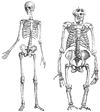
Ape study Ape language · Ape Trust · Dian Fossey · Birutė Galdikas · Jane Goodall · Chimpanzee genome project · Human genome project · Neanderthal genome project · Willie Smits · Lone Drøscher Nielsen · Borneo Orangutan SurvivalLegal and social status See also Bushmeat · Ape extinction · List of notable apes · List of fictional apes · Human evolution · Mythic humanoids · HominidCategories:- IUCN Red List least concern species
- Apes
- Humans
- Megafauna
- Megafauna of Australia
- Megafauna of South America
- Megafauna of Africa
- Megafauna of Eurasia
- Megafauna of North America
- Tool-using species
- Cosmopolitan species
- Animals described in 1758
- aethiopicus
Wikimedia Foundation. 2010.

